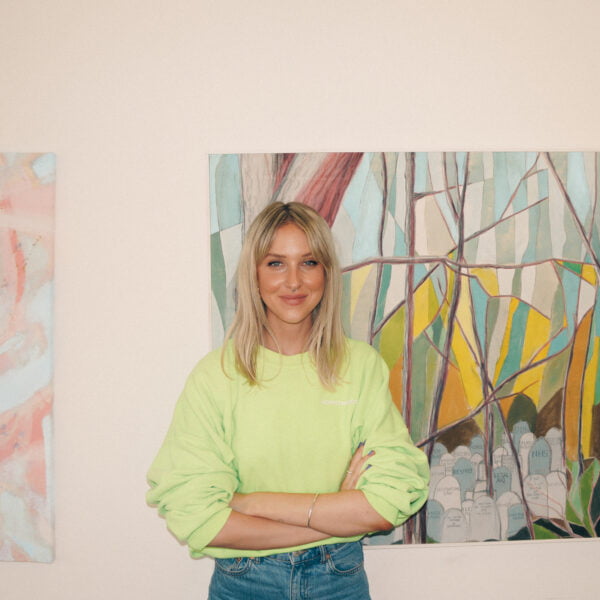
Natasha Collie
Senior Brand Marketing Manager at Penguin Random House UK
At the start of the year, Ladybird Books approached Sonder & Tell with a dream brief. In 2021, a year that’s been particularly challenging for...
In conversation with
Content Director at WePresent

As brands have caught onto the value of organic content, we have access to more essays and opinions than ever before. But while a lot of people just add to the noise, WeTransfer’s new vertical WePresent adds value with its unexpected stories of creativity.
WePresent’s Content Director, Holly Fraser, doesn’t see their platform as “content marketing in the traditional sense”. But in the brand world, everyone wants a content platform like WeTransfer. Perhaps it’s because they’ve been able to create content that people want to read that actually makes business sense too. “75% of WeTransfer’s audience of up to 70 million people a month identify as working within the creative industry, so WePresent becomes a great resource for them on a near daily basis.”
We caught up with Holly to talk about how WePresent tells stories, the visuals that stimulate the power of words, and the real value of editorial content for a brand.
When we say ‘unexpected’ we mean stories that you won’t necessarily find on other platforms that perhaps have to follow a certain news cycle or have to publish a larger quantity of stories per day. At WePresent what is important to us is getting to the core of an artist’s practice, and going behind the final project to unearth the often messy and unexpected process underneath. This can often take a while, and is one of the reasons we publish only a few times a week, but we believe that the magic often happens in the creative journey. That’s the part that teaches us something – what went wrong, what was the challenge, how did you get over your creative block. We also work hard to make sure the stories that we tell are as representative as possible as creativity means so many different things to people depending on where you’re from or what your background is. I think that we’re all a bit guilty of getting stuck in our own echo chambers from time to time, and because of this a lot of creative work is seen through a Western gaze, but there are so many fascinating stories and perspectives to be uncovered if we all just look a bit harder. We’ve worked with artists from over 85 countries, and whether from Mongolia or Mexico, the work teaches us something new almost every time.
We launched our new writing vertical last year when our story editor Liv joined the team, and she was tasked with making us stand out in the literary space. From this, our series Literally was born which is our ever-expanding library of work from writers that we admire. Importantly though, we want to work with writers that share our beliefs and values – we want to create essays that are representative and challenging and have the power to start conversations, while still just being really brilliantly written. This was the case, for example, when Roxane wrote her take on monuments being ingrained in a racist society which was an important piece of work on a very relevant topic.
Like everything we do, commissioning is a very collaborative process. We have a team discussion about the type of stories we want to create and figure out who we think could tell them in the best way. We’ll have a chat with the authors and then come to an agreement about what feels right and what they’d like to say. We would never force someone to cover any particular topic because it would just feel inauthentic and we want to foster working relationships where people feel proud of the work we create together. We’ve worked with Roxane for over a year now and she’s utterly brilliant.

This year I would definitely say working with Riz Ahmed on the short film The Long Goodbye. The film came out in March but we’d been collaborating on it for over six months by that point and the end result is one of the most powerful shorts I’ve maybe ever seen. You feel like you’ve been punched in the stomach by the end of the 11 minutes. It’s directed by Aneil Karia and looks at an alternate future that in today’s climate is worryingly, not so hard to imagine. The film is focused on racism and hate crime in the UK, but it has a global message. Work like that feels important and necessary in times like these, and it was such a privilege to collaborate on something of that nature with an artist as talented as Riz.
– Have I seen this before and does it feel original?
– Have we done this story justice and told it in the best way we possibly could?
– Do I care?
The last one is maybe the most important. I think you have to be pretty invested in the work that you do in order to produce something worth talking about.
The idea of a lucky dip is almost exactly it. We want that element of surprise, and of the unexpected to guide people so that landing on a story feels almost serendipitous. We’ve had people say that it feels like falling down a rabbit hole and they’ve spent ages weaving through the site. When WePresent was built just over two years ago our design team didn’t want it to look like every other site on the internet that spells out exactly what it is. It wasn’t meant to be obvious, but more like a big gallery of inspiration. We’ve had that design for two years though so we’ve been having conversations recently about what comes next. Watch this space!


Hugely! No matter how interesting or important a story is so many people will be attracted to the visuals first. Creative thinkers often think in design and pictures over words so for us they’re as important as each other. The visuals have to act as the hook to catch the reader and draw them in, and often guide them through the story too. They add a layer of context that makes each story a much richer experience. Plus, they’re often the most shareable part of the story. We commission almost everything you see on the site and our visual commissioning editor Suzanne has a huge roster of photographers and illustrators from all over the world that we work with to ensure that our visuals are representative of the breadth of artists that we work with. She’s our secret weapon!
Through the work that we do on WePresent we uphold the values that underpin WeTransfer as a company. For example, WeTransfer has always given away 30% of its advertising inventory to support artists, creative communities and causes that we believe in. And through the stories we tell on WePresent we further spotlight those creatives and give them a platform to be seen. Every story that features on WePresent is also shared globally via WeTransfer wallpapers so the reach and attention that an artist can receive is pretty huge. I think it’s important to note that WePresent was never founded with the intention of being a sales tool or anything like that, but instead a space where our creative audience that use WeTransfer everyday anyway can get inspired and learn more about global creativity to then go and further their own ideas. And if we were brought to life? Think of WePresent as WeTransfer’s slightly rebellious, more outspoken little sister. Maybe we bend the rules from time to time…
“I think if other brands follow our lead and make work that comes from an authentic place, that creates opportunities for journalists, photographers and artists then that’s a good thing.”
WePresent allows WeTransfer’s audience to constantly engage with new ideas and points of views from artists all over the world – in photography, music, film and art. Equally 75% of WeTransfer’s audience of up to 70 million people a month identify as working within the creative industry, so WePresent becomes a great resource for them on a near daily basis. It’s another tool at their disposal in order to inspire and further their creative ideas. But WePresent also allows WeTransfer to be vocal about what we believe in and, as a company, that is very important to us. This year we became a B-Corp which means that we are dedicated to responsibility, sustainability and inclusivity, which we also take into account with all the work that we create for WePresent. In today’s climate people want to work with – and spend their money with – brands that align with their values and that feel like humans not big faceless corporations.
With regards to changing the landscape of digital content, I think that publishing is in a state of flux right now and the lines between what is considered branded content and journalism are becoming ever thinner. We don’t view WePresent as ‘content marketing’ in the traditional sense. The platform is run by a team of arts journalists striving to create conversation-worthy work that makes an impact. I think if other brands follow our lead and make work that comes from an authentic place, that creates opportunities for journalists, photographers and artists, then that’s a good thing.
Firstly, have values and stick to them. I really believe that authenticity is key. Readers are smart and will see straight through any performative bullshit. And they’ll call you out for it too! Develop editorial guidelines and be clear about what you stand for and what you want to achieve, and make sure that your content matches your brand and speaks to your audience. Will they find it interesting, or useful, or funny? And finally ask yourself, would I read this? If the answer is yes, you’re on to a winner.

Senior Brand Marketing Manager at Penguin Random House UK
At the start of the year, Ladybird Books approached Sonder & Tell with a dream brief. In 2021, a year that’s been particularly challenging for...

Founder Of Simple Politics
Talking about serious issues doesn’t mean defaulting into a serious tone of voice, or using complicated language. If anything, accessibility, clarity and a touch of...

Brand & Community Manager at Homethings
Creating a tone of voice from scratch can be challenging. But a blank slate to work from also mean there’s room for something a bit...

Founder Of Novel Skincare

Literary Agent